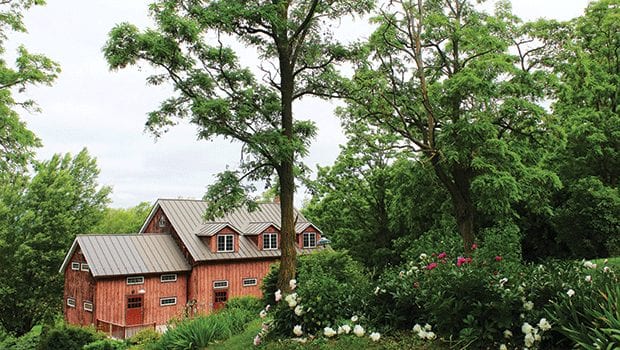
Lydia Clemmons “junior” stands in the square wood silo of the 18th-century barn on her family’s farm in Charlotte, Vermont. She grew up feeding the livestock in the main room next door. Now, she holds a beautiful, handcrafted African vase and points out the intricate carvings. At her feet lie dozens of worn, brown boxes with equally priceless artworks inside. The 148-acre Clemmons Family Farm is the only site on Vermont’s African American Heritage Trail with living residents and living stories. “We are the bridge between the past, the present and the future,” Clemmons says.

Author: Celina ColbyArt adorns the barn of the Clemmons Family Farm in Charlotte, Vermont.
On the Web
For more information about Clemmons Family Farm, visit: http://www.clemmonsfamilyfarm.org/
Of the 7,300 farms in Vermont, only 19 are owned or operated by African Americans. Lydia’s parents, Jackson and Lydia “senior” are now in their mid-90s and their days of farming are over, but they wanted to preserve the culture and heritage of the farm and share it with the community. The farm now serves as a multicultural art space, hosting a variety of events related to the art and history of the African diaspora. Last week, they staged an Ethiopian coffee ceremony and author Donna Sherard read from her children’s book “The Splendiferous Adventures of Ryan Odongo.”
The farm’s primary visitor space, The Barn House, carries a wealth of art and family history. Jackson Clemmons built the stunning residence by combining two smaller barn buildings from other areas of the property. He was 73 at the time. It becomes clear after a few moments with the Clemmons patriarch that this was no ordinary household. On paper, Jackson was a pathologist and professor at the University of Vermont. He and Lydia senior also traveled extensively in Africa, where he studied the HIV virus and she began an import business of African art.
It’s clear from the design of The Barn House that he was also an artist. Large windows that he picked up for free from the roadside create beautiful, airy room partitions. Stone, brick and wood intertwine for a textural interplay “Country Living” would write sonnets about. The building is decorated with rare African art gems Lydia senior brought back during her art dealing days. If you open the white marble table in the living room of the downstairs apartment, you can see Jackson’s wood-block prints of farm life, a la Hokusai.
The Barn House serves as part residence, part exhibition space, currently showing a selection of posters from the National Museum of African American History and Culture in Washington. Opening July 1, “The Power of Color” features portraits and statements by high school students from Hardwick, Vermont, who have struggled to come to terms with their ethnic identity in an overwhelmingly white state. The group reached out to Lydia junior looking for a place to exhibit their work and explore their cultural history. She’s currently working on developing more collaborations of this kind, where groups and individual artists can convene on the farm to create, connect and grow.
For Lydia junior, that’s what this project is about: coming home. She finds that people are drawn to the farm as a place to feel connected to and to explore their cultural roots. She says, “Especially in this time, this place is where people can come and create positive experiences with different cultures. This is a place where people can come to find themselves.”




![Banner [Virtual] Art Gallery](https://baystatebanner.com/wp-content/uploads/2024/04/NJ-H_1-713x848.jpg)

